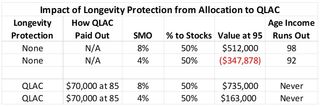For Longevity Protection, Consider a QLAC
A qualifying longevity annuity contract, or QLAC, can help you define a better retirement for yourself by providing guaranteed lifetime income.


Please consider two new terms you should know in retirement:
- Longevity protection. The steps you can take to ensure that the money you thoughtfully saved and carefully grew during your working years doesn’t run out before you do, no matter how long you live.
- Qualifying longevity annuity contract. Commonly called a QLAC, this type of deferred income annuity funded out of your rollover IRA account provides guaranteed lifetime income starting at an age you select but no later than 85.
I’m not trying to turn you into an actuary or pension specialist, but an understanding of those terms can make a huge, positive difference in your plan for retirement income and your peace of mind.
Planning for a long life
Living too short a life is unfortunate and sad. So is living so long you outlast your savings. However, while we can’t say with certainty how long we will live, we can prepare ourselves if we are surprised by living beyond our life expectancy.

Sign up for Kiplinger’s Free E-Newsletters
Profit and prosper with the best of expert advice on investing, taxes, retirement, personal finance and more - straight to your e-mail.
Profit and prosper with the best of expert advice - straight to your e-mail.
A poll conducted by the Global Financial Literacy Excellence Center with the research organization TIAA Institute, showed that most of us aren’t thinking enough about how long we might live and the new set of late-in-life expenses. More women are well-versed in the details of longevity than men, the poll shows. Financial literacy follows the same trend.
For the basics, if you’re like our sample 70-year-old female retiree, according to certain actuarial models your life expectancy is 89 if you’re in good health; it’s 87 for a man. Remember this factoid: 50% of you will live beyond life expectancy.
Most of us will be able to count on Social Security — and it’s a lifetime benefit. Will benefits be cut when, without governmental intervention, the Social Security program becomes insolvent in or around 2033? Only Congress can tell. And what percentage of your budget is covered by Social Security?
Retirement income alternatives
Traditional retirement income planning, using only investments, predicts how long your savings will last based on probabilities. Certainty is better when faced with these life risks. In other words, you need planning that allows you or your adviser to bring in longevity protection, and while the government isn’t always the first place we look for solutions, a QLAC, which Congress approved and recently expanded, addresses longevity protection with guaranteed income starting later in life.
As I wrote in my article Curious About a QLAC? SECURE 2.0 Act Gives This Annuity a Boost, “A QLAC is technically a deferred income annuity purchased by a tax-free transfer of a portion of your tax-qualified accounts generally made after age 55. That transfer, in addition to adding a QLAC to your plan, represents a reduction in your account for the purposes of determining taxable required minimum distributions, or RMDs. So, if you used 25% of a $400,000 qualified account, your $100,000 purchase of a QLAC would immediately reduce your RMDs by 25%. And the income from a QLAC could be deferred until as late as age 85.”
Sounds a little technical, but the easier version is that you can spend up to $200,000 from your pre-tax accounts like a 401(k) to buy a QLAC, which will defer RMDs on that amount. At the same time, income payments will begin at an age you decide — no later than 85.
QLAC recipients can use the money for whatever they choose, including a trip to Paris or season box seats to their favorite NFL team. But often they spend it on late-in-life health care or housing costs that otherwise might force them to move out of their long-term homes.
How it works
Providing longevity protection through a QLAC can minimize and even eliminate the risks of running out of money.
Let’s use the Go2Income planning tool and some standard assumptions to measure the risks and rewards. To simplify that analysis, we’ll use our sample investor, Sally, age 70, with $1 million of retirement savings in a rollover IRA account. She understands that she can and must do better than the 4% rule (or $40,000 per year) and instead is targeting 6%, or $60,000 per year, growing at 2% a year until age 85. That additional income of $20,000 and growing can make a big difference in her plan — provided it lasts a lifetime.
She orders two Go2Income plans with only investment portfolios and a 50/50 split between stocks and bonds. It’s a little aggressive, but she needs that to meet her ambitious goal of $60,000 annually. Her first plan assumes a long-term return in the stock market of 8%, and she ends with $512,000 at age 95. So far so good. Then she tests her second plan at a lower rate of return of 4%, which has occurred over long periods, about 10% of the time. In this case, her savings run out at age 92. Of course, the years before the run-out will be a time of high anxiety.
Now Sally tests the investment of $200,000 from her rollover IRA savings to purchase a QLAC. She runs the same two stock market scenarios and learns that a QLAC keeps the plan going for life. At an 8% stock market return, her plan is worth $735,000; at 4%, her plan has not run out of money — and she has $70,000 of guaranteed income for the rest of her life coming from a QLAC.
Here is a summary of the results:

Convinced of the efficacy of longevity insurance and QLAC, she tested different options to deploy the QLAC in her plan: (a) laddered QLAC income — reduces longevity protection but acts as an income inflation hedge; or (b) beneficiary protection — reduces late-in-life longevity protection in return for protecting her beneficiary in case of early passing. Visit our QLAC calculator to get a free quote to evaluate these options.
Other forms of income that suggest a need for longevity protection
The important part is to have a tool, like Go2Income, that can provide a fair and objective analysis of the advantages and disadvantages of QLAC or other options. While you’re at it, here are some other income streams that might need protection:
- Rental property that will be sold
- A 10- to 15-year payout from a business or investment
And probably the biggest — drawdowns from the equity in your home. In the next article, we will discuss how by using a home equity conversion mortgage (HECM), also known as a reverse mortgage, you can generate additional tax-free cash flow to 85 and substantial liquidity after 85. A QLAC is what makes it work.
Whether you consider a QLAC as a stand-alone improvement to your retirement, or integrated within Go2Income, order a complimentary Go2Income plan to help you find the best, most efficient plan for your income future.
Related Content

Jerry Golden is the founder and CEO of Golden Retirement Advisors Inc. He specializes in helping consumers create retirement plans that provide income that cannot be outlived. Find out more at Go2income.com, where consumers can explore all types of income annuity options, anonymously and at no cost.
-
 Strategies to Optimize Your Social Security Benefits
Strategies to Optimize Your Social Security BenefitsTo maximize what you can collect, it’s crucial to know when you can file, how delaying filing affects your checks and the income limit if you’re still working.
By Jason “JB” Beckett Published
-
 Don’t Forget to Update Beneficiaries After a Gray Divorce
Don’t Forget to Update Beneficiaries After a Gray DivorceSome states automatically revoke a former spouse as a beneficiary on some accounts. Waivers can be used, too. Best not to leave it up to your state, though.
By Andrew Hatherley, CDFA®, CRPC® Published
-
 Strategies to Optimize Your Social Security Benefits
Strategies to Optimize Your Social Security BenefitsTo maximize what you can collect, it’s crucial to know when you can file, how delaying filing affects your checks and the income limit if you’re still working.
By Jason “JB” Beckett Published
-
 Don’t Forget to Update Beneficiaries After a Gray Divorce
Don’t Forget to Update Beneficiaries After a Gray DivorceSome states automatically revoke a former spouse as a beneficiary on some accounts. Waivers can be used, too. Best not to leave it up to your state, though.
By Andrew Hatherley, CDFA®, CRPC® Published
-
 What’s the Difference Between a CPA and a Tax Planner?
What’s the Difference Between a CPA and a Tax Planner?CPAs do the important number crunching for tax preparation and filing, but tax planners look at the big picture and come up with tax-saving strategies.
By Joe F. Schmitz Jr., CFP®, ChFC® Published
-
 Charitable Remainder Trust: The Stretch IRA Alternative
Charitable Remainder Trust: The Stretch IRA AlternativeThe SECURE Act killed the stretch IRA, but a properly constructed charitable remainder trust can deliver similar benefits, with some caveats.
By Brandon Mather, CFP®, CEPA, ChFEBC® Published
-
 Three Ways to Take Control of Your Money During Financial Literacy Month
Three Ways to Take Control of Your Money During Financial Literacy MonthBudgeting, building an emergency fund and taking advantage of a multitude of workplace benefits can get you on track and keep you there.
By Craig Rubino Published
-
 How Did O.J. Simpson Avoid Paying the Brown and Goldman Families?
How Did O.J. Simpson Avoid Paying the Brown and Goldman Families?And now that he’s died, will the families of Nicole Brown Simpson and Ron Goldman be able to collect on the 1997 civil judgment?
By John M. Goralka Published
-
 What Not to Do if an Employee or Loved One Is Kidnapped
What Not to Do if an Employee or Loved One Is KidnappedBusinesses need to have a crisis plan in place so that everyone knows what to do and how to do it. Sometimes, calling the authorities isn’t recommended.
By H. Dennis Beaver, Esq. Published
-
 Why You Shouldn’t Let High Interest Rates Seduce You
Why You Shouldn’t Let High Interest Rates Seduce YouWhile increased interest rates are improving the returns on high-yield savings accounts, that may not be an effective place to park your money for the long term.
By Kelly LaVigne, J.D. Published